Automatic Promotions (Legacy Editor)
Automatic Promotions are a way to set up product discounts based on whether the customer's shopping cart has met specific criteria, such as including certain products or brands, reaching a set order amount, or even whether the customer has purchased before. Shoppers won't need to enter in a coupon code, as the promotion is automatically applied, leading to less friction on the checkout.
Sales can be scheduled in advance, as promotions can be created with a set start and end date. This allows you to focus on promoting your sale through social media and email marketing, rather than manually managing the promotion in the control panel.
Due to the nature of Automatic Promotions, they will not be apparent to the customer until after they have added products to their cart. For this reason, we recommend advertising your discounts with a marketing banner or on your store's carousel.
The standard editor offers additional functionality for creating promotions. Exclude promotions, limit promotions to certain days or weeks, create fixed price promotions, and more. See Automatic and Coupon Promotions (Standard Editor) for more information.
Requirements
- To manage Automatic Promotions, you must have the following permissions enabled on your user account:
- Manage Promotions
- Edit Promotions
- Add Promotions
- Delete Promotions
- To limit promotions to specific Customer Groups, your store must be on a Plus plan or higher.
Types of Automatic Promotions
Shipping discounts
- Order at least X units of product Y, get free shipping to specific shipping zones
- Orders totaling more than amount, get free shipping to specific shipping zones
Just so you know... If your discount conflicts with your shipping zone setup, the promotion will take priority over the shipping zone rule.
Product discounts
- Buy one get one free
- Buy one get something else free
- Buy (X units) of Product A, get (Y units) of Product B for $ or % off per unit
- Apply an amount or % off to Product X
To learn more about this discount, see Creating Product Level Discounts.
Brand discounts
- Apply a $ or % discount to each item in one or more brands (can exclude certain brands)
Category discounts
- Apply an amount or % off each item in one or more categories (can exclude certain subcategories)
- Buy X units in (Category A), get Y additional units in the same category free (must be of equal or lesser value)
- Apply a tiered discount to applicable products based on the quantity of items ordered within one or more categories
Order discounts
- Spend at least the specified amount, apply an amount or % discount to the order subtotal
- Spend at least the specified amount, get one unit of Product Y for an amount or % off
- Spend at least the specified amount, get Y% off (one or all) unit(s) of the (least or most) expensive item(s) in the cart
Customer discounts
- Discount amount for repeat customers
- X% discount for repeat customers
Offering a free item? If you are using one of the Buy One Get One discounts, there will be an additional option to add any eligible free product automatically to the shopper's cart. By default, this option is enabled. If you disable it, shoppers will need to click the eligible banner prompt on the cart page and manually add the free product to their cart.
Viewing Automatic Promotions
Go to Marketing › Promotions to see your active and disabled promotions in the Promotions Manager.
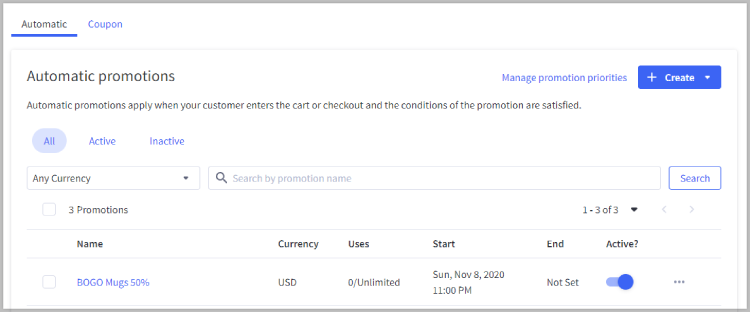
In addition to the list of promotions, you can also see the following statistics and settings:
- Currency — the currency the promotion will affect. Percentage-based discounts can optionally be applied to "All Currencies".
- Uses — how often the promotion has been triggered / total number of allowed uses
- Start — the date and time for the promotion to activate
- End — the date and time for the promotion to expire
- Active? — whether or not the promotion is currently active; toggle to enable/disable

Use the tabs to filter your promotions and view only active or inactive promotions. ;By default, you will see all promotions. You can also filter by currency, using the dropdown menu. You will find all of the currencies set up under Settings › Currencies available as filters. This allows you to combine the two sets of filters for even greater precision, such as only displaying active promotions available to customers using Canadian Dollars.
Use the search field ;to search by promotion name. This is extremely useful if your store has more than one page of promotions or when you're looking for a specific promotion.
Creating an Automatic Promotion
To create an automatic promotion, go to Marketing › Promotions, click Create and select With legacy editor from the drop-down list.
Enter a Promotion Name and select which currency the promotion will affect (for percentage-based discounts, you can also optionally apply the discount to "All Currencies"). Promotion Name is an internal name that you can use to keep track of your discounts and will not be displayed to customers.

Select a Promotion Type from the drop-down list, then select the individual discount you wish to use. See Types of Automatic Promotions above for a full list of discounts and promotion types.
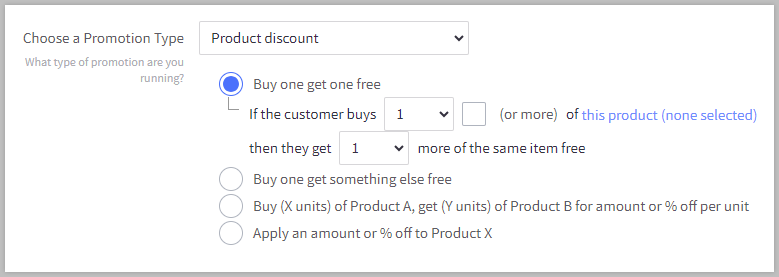
If you are using a promotion that requires additional information, such as selecting a particular product or category, add that information now. When selecting products, you can choose a "parent" product (all options) or a specific variant SKU.
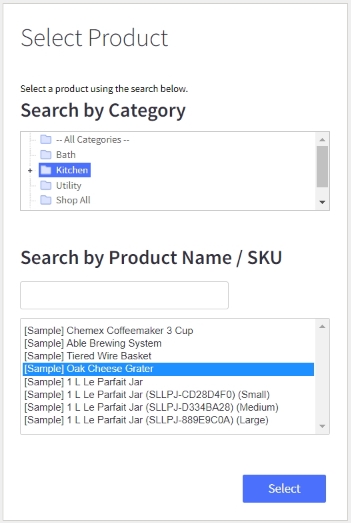
Select All Customers or a specific Customer Group. to specify which customers are eligible to receive the promotion. For example, you may want to limit the discount to wholesale, high-value, or new customers. For more information, see Customer Groups.
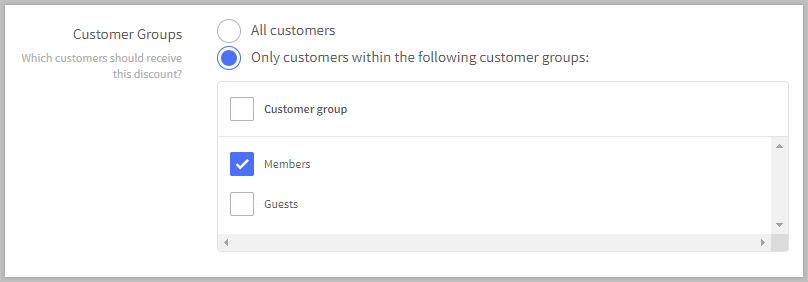
Choose the promotion's Duration. Use this to specify a start date and time for your promotion to run. Select your start date from the calendar, and the start time from the dropdown. Click Add end date to specify a date and time for the promotion to expire, then set the date and time. Promotions will use the time zone in your Date and Timezone Settings. For more on the Duration feature, see Duration Dates and Times.

You can limit discounts to a certain number of uses by enabling the Limit the usage of this discount option.
- This discount can only be used X time(s) — refers to total uses, not uses per customer
You can limit discounts to not apply to items with sale pricing by enabling the Exclude Items on Sale option. This option is only available for Product, Brand, and Category promotion types.
Click Activate to make your promotion begin taking effect. Unchecking it will disable the promotion, but keep it in your control panel for later use.

Duration Dates and Times
The duration settings allow you to set a specific period during which your promotion should run. When selecting your date period, keep the following in mind:
- All dates and times will be in your store's time zone (see Date and Timezone Settings).
- Rules will only apply to orders placed after the rule was created, regardless of start date and time.
- If you update your store's time zone or change the Daylight Savings Time setting, your rule will start at its original starting time. For example, if your rule is set to begin at noon, and you move forward one hour in time, your rule will now start at 11 am in your new time zone.
Promotion Banners
Promotion messaging can be placed in various areas of the store to upsell, announce eligibility, and congratulate shoppers. The banners will trigger only if the shopper meets the parameters of the discount and if content has been added to the appropriate banners. Only one banner will display at a time for a specific promotion at the different stages of eligibility and application of the discount.
Promotion banners are optional and utilize the WYSIWYG Editor so they can include images and links to specific pages. You can also use placeholders to inject certain information into the banners.
By default, the banners will take on the theme's styling and look like this:

Congratulations Banner Message
This banner displays on the cart page when the shopper has qualified for the discount, and it has been applied.

Eligible Banner Message
This banner displays on the cart page when a shopper meets the conditions to qualify for a promotion, but must add the reward to the cart themselves. It's useful for Buy One Get Something Else free situations, where the shopper needs to select options before adding the reward item to the cart.

Upsell Banner Message
This banner can be placed on the home, product, cart, and checkout pages. The message appears when a shopper has added something to their cart but does not qualify for a discount yet.

Promotional Banner Message
The promotional banner is used to upsell products that are unrelated to what a shopper has already added to their cart, and will show when products that aren't part of the promotion have been added to the cart. It will not appear for empty carts or carts that meet the requirements of another promotion, such as free shipping for orders over a certain amount.

Placeholders
These placeholders can be used in the above message boxes. Some placeholders only apply to certain Discount types.
- %%condition.required%% — The total number of items or spend amount required to satisfy the condition.
- %%condition.matched%% — The number of matching items in the cart or the cart subtotal contributing to satisfying the condition.
- %%condition.remaining%% — The number of items or spend amount remaining to qualify.
- %%action.discount.applied%% — The actual discount amount applied by the rule.
- %%action.discount.configured%% — The discount amount set when the rule was created.
- %%action.offers.redeemed%% — The number of items that have been discounted.
- %%action.offers.redeemable%% — The number of items for which a discount is available but not redeemed.
- %%action.offers.total%% — The total number of items eligible for discount.
Manage Promotion Priorities
Multiple promotions can apply to the same order. The sequence in which these promotions are triggered is configured under Manage promotion priorities.
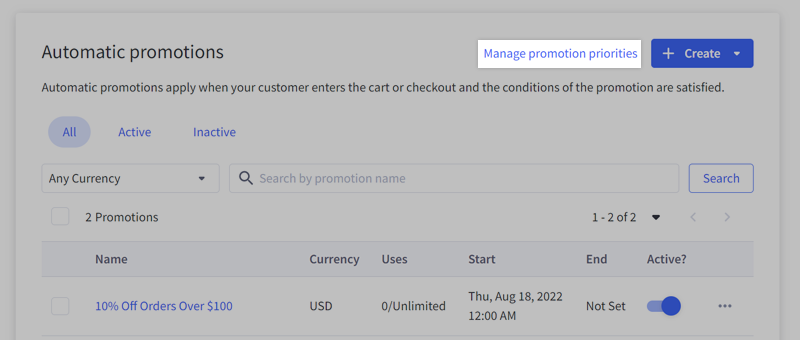
Promotions will trigger (top to bottom) in the sequence that they appear in this list. Click and drag promotions up or down in the list to change their priority. Priority assignment is important as it can play a big role in how your various promotions interact with each other on orders.
For example, you can have one promotion that gives shoppers free shipping on orders over $100, and another that offers 10% off orders over $100.
If the priority is set so that the free shipping promotion is applied first and the 10% discount is applied second, then when the shopper’s cart reaches $100, they would (first) qualify for free shipping, then (second) receive 10% off their order, bringing the order total to $90. In this scenario, the shopper has effectively qualified for free shipping by only spending $90, which is probably not what you intended.

You can remedy this by changing the priority so that the 10% discount happens first, and the free shipping promotion runs second. That way, the shopper receives the 10% discount, but will still need to spend at least $100 before qualifying for free shipping.

Stop After This Rule
In addition to changing the order of operations, you can also use Stop after this rule to prevent subsequent promotions from firing after a specific promotion has been triggered.
For example, you may have separate promotions for 10% off orders over $100 and 20% off orders over $200. Your intent is for the shopper to receive one of these discounts, but not both.

In this case, you should give the bigger discount a higher priority and check Stop after this rule so the smaller discount isn’t also applied to the order.

This example is just to illustrate how Stop after this rule can work. A better way to implement the above discounts would be to use multiple discount tiers in the same promotion.
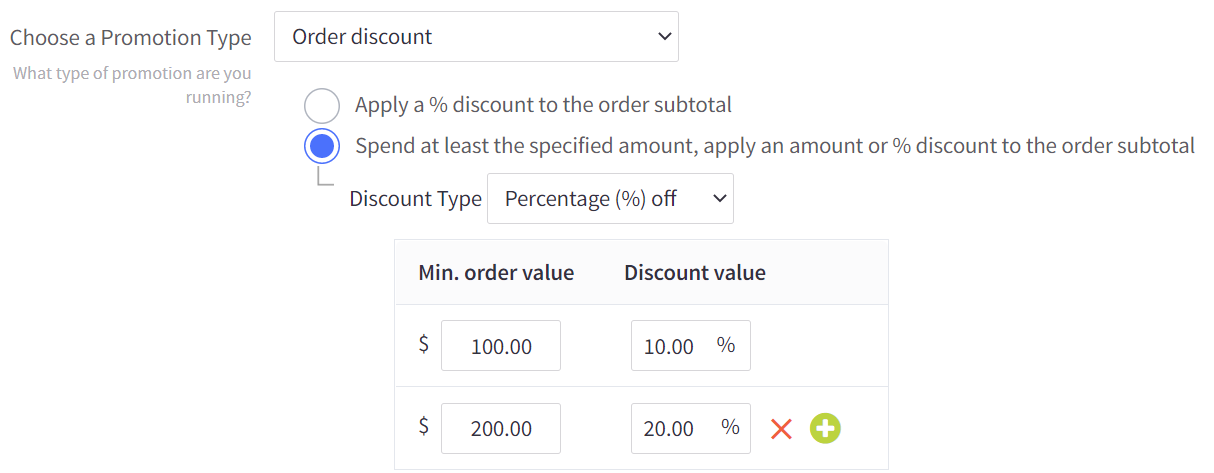
Note that the stop rule only applies if the conditions of the promotion have been satisfied, not if the shopper merely qualifies for the promotion. For example, you may have a “Buy Product X, Get 50% Off Product Y” promotion. The shopper would have to trigger the promotion (and thus the stop rule) by adding both Product X and Y to their cart. The promotion would not trigger by the shopper simply being eligible for the discount by adding only Product X to their cart.
FAQ
What do promotions look like to customers?
When your customer goes through checkout, they will see a discounted price showing how much their order was discounted. It will not show on the product or category pages.
How many Automatic Promotions can I have?
To avoid performance issues, we recommend having less than 100 active Automatic promotions, with no more than 10 rules each. Exceeding these recommendations can result in slower page load speeds for your shoppers.
Why is my newly-created promotion not applying to existing carts?
Promotions are calculated as products are added or removed to a cart. To recalculate a cart and trigger any applicable promotions, update or empty any existing carts before adding the affected products.
Will Automatic Promotions affect gift certificates?
No. Gift certificates are excluded from Automatic Promotions.
How do I create a product discount automatic promotion?
Go to Marketing › Promotions and click Create. Choose Product discount as the promotion type, then choose Apply an amount or % off to Product X. The Add Free Product automatic promotion will only become available when the percent off per unit is set to 100%. Save your changes.

How do Automatic Promotions interact with manual discounts?
Manual discounts are applied when creating a manual order or when editing an existing order.
- Manual Orders: Manual discounts will be additive to Automatic Promotions and Coupon Promotions.
- Existing Orders: Manual discounts will override Automatic Promotions, but be additive for an already applied Coupon Promotion.
Can I choose how multiple promotions applied to products in a cart are calculated?
Yes. Promotion Settings can be accessed in Settings › Miscellaneous. You can choose to calculate multiple promotions per order independently or cumulatively.
- Independently: each promotion is applied to the original price of the included products.
- Cumulatively: promotions work cumulatively off each other, with each subsequent discount applied to the preceding discount based on your promotions order.
Note that this feature is store-wide, not channel specific. This means that the setting will apply to all storefronts.

Can products with a zero price be used to trigger a promotion?
The setting allowing zero price products to trigger promotions can be toggled on or off in Settings › Miscellaneous under Promotion Settings.
Note that this feature is store-wide, not channel specific. This means that the setting will apply to all storefronts.
Will promotions apply discounts to products with overridden pricing?
By default, products with custom pricing, including pricing overridden by manual order or server-to-server Cart APIs, are excluded from promotions. You can allow these products to be eligible for promotions by enabling the setting in Settings › Miscellaneous under Promotion Settings.
Note that this feature is store-wide, not channel specific. This means that the setting will apply to all storefronts.
How does rounding work with percentage-based discounts?
Percentage-based discounts use normal rounding. We round down for 0.004 and less, and round up for 0.005 and greater.
How do category exclusions work for products in multiple categories?
Products that meet any category exclusion rule are excluded from the promotion. For example, a product in both the Boots and Sale categories would not be eligible for any promotions that exclude the Sale category.
To avoid unintended product exclusions, we recommend reviewing the products assigned to the excluded categories. You can do this using the category Action menu View products link or by exporting your products.
Can I edit a promotion in the control panel if it was created via the API?
Promotions created with the Promotions API can be edited in the control panel as long as they only use rules which can be configured with the standard editor. Note that API-created promotions cannot be edited using the legacy editor.
If the promotion uses conditions that can only be configured via the API, such as multiple logical operators, it is marked with a tooltip to indicate that the promotion must be updated via the API.

Why aren't some of my promotion's banners appearing on the storefront?
Certain promotion types will not display all banners to shoppers on your storefront. A promotion that does not have eligibility conditions, such as one that applies a category discount without a minimum purchase amount, will display the promotional and congratulations banners. However, the upsell and eligible banners won't appear since the discount is applied automatically.
 © Copyright 2003 - 2024 BigCommerce Pty. Ltd. Shopping Cart Software
© Copyright 2003 - 2024 BigCommerce Pty. Ltd. Shopping Cart Software